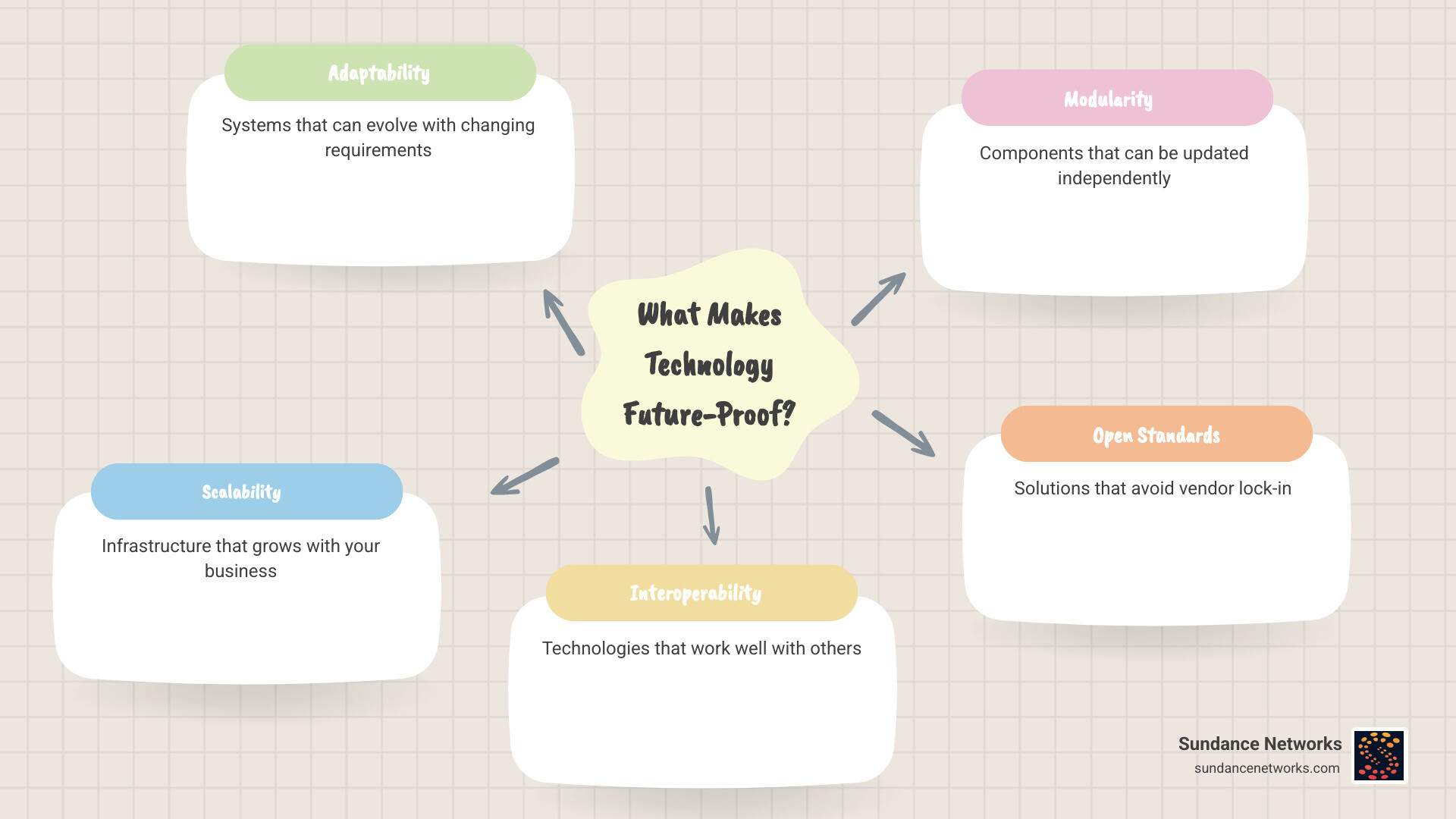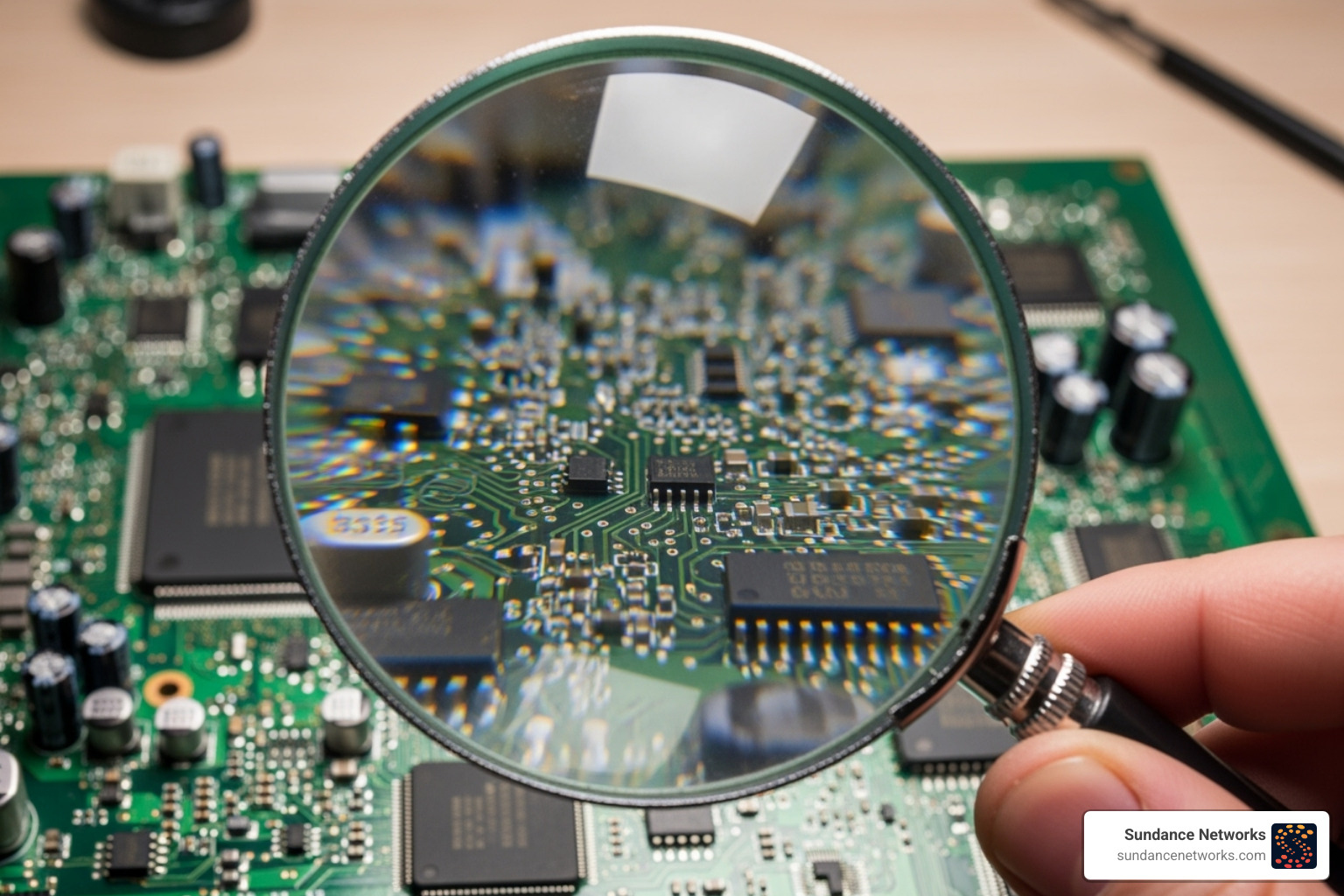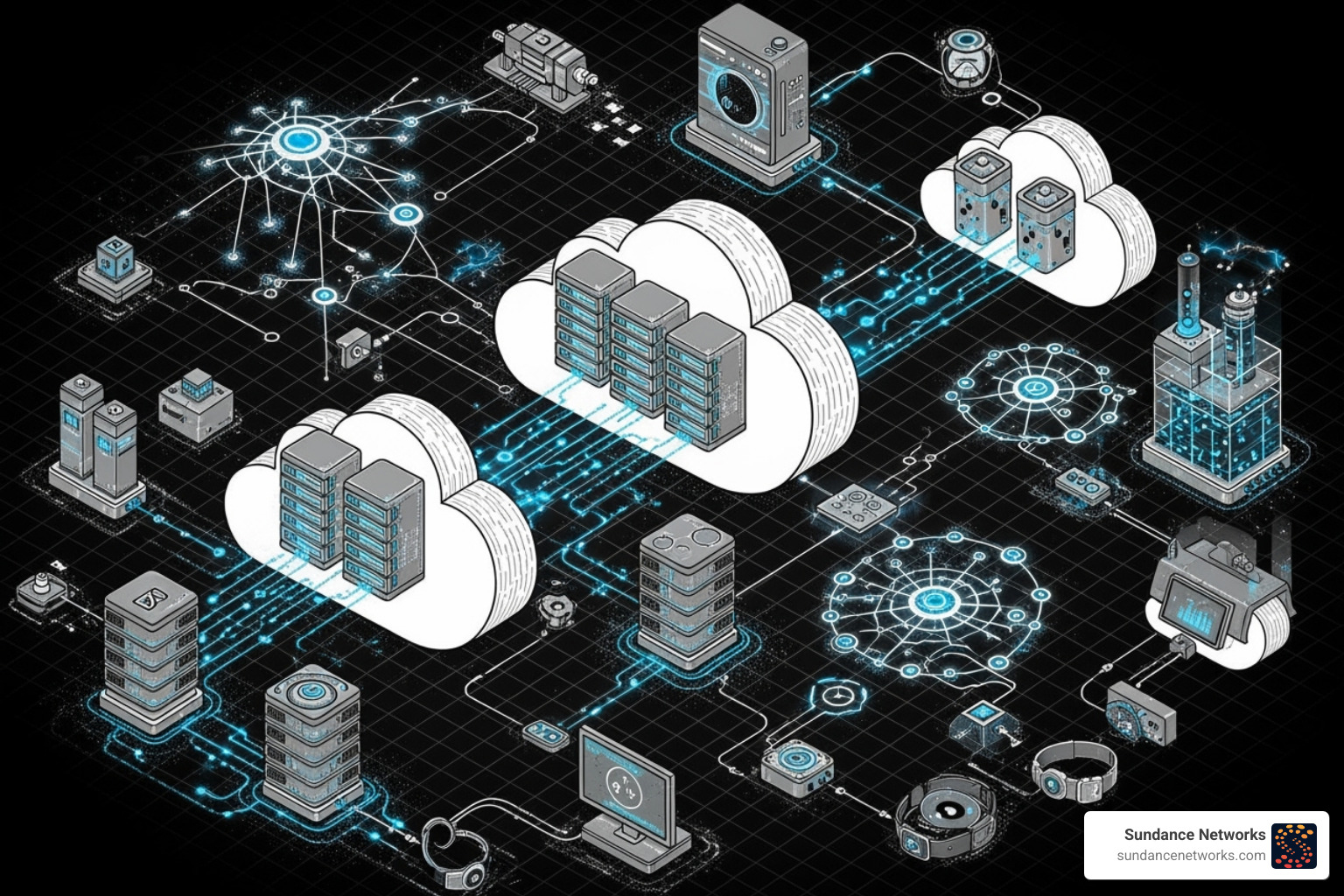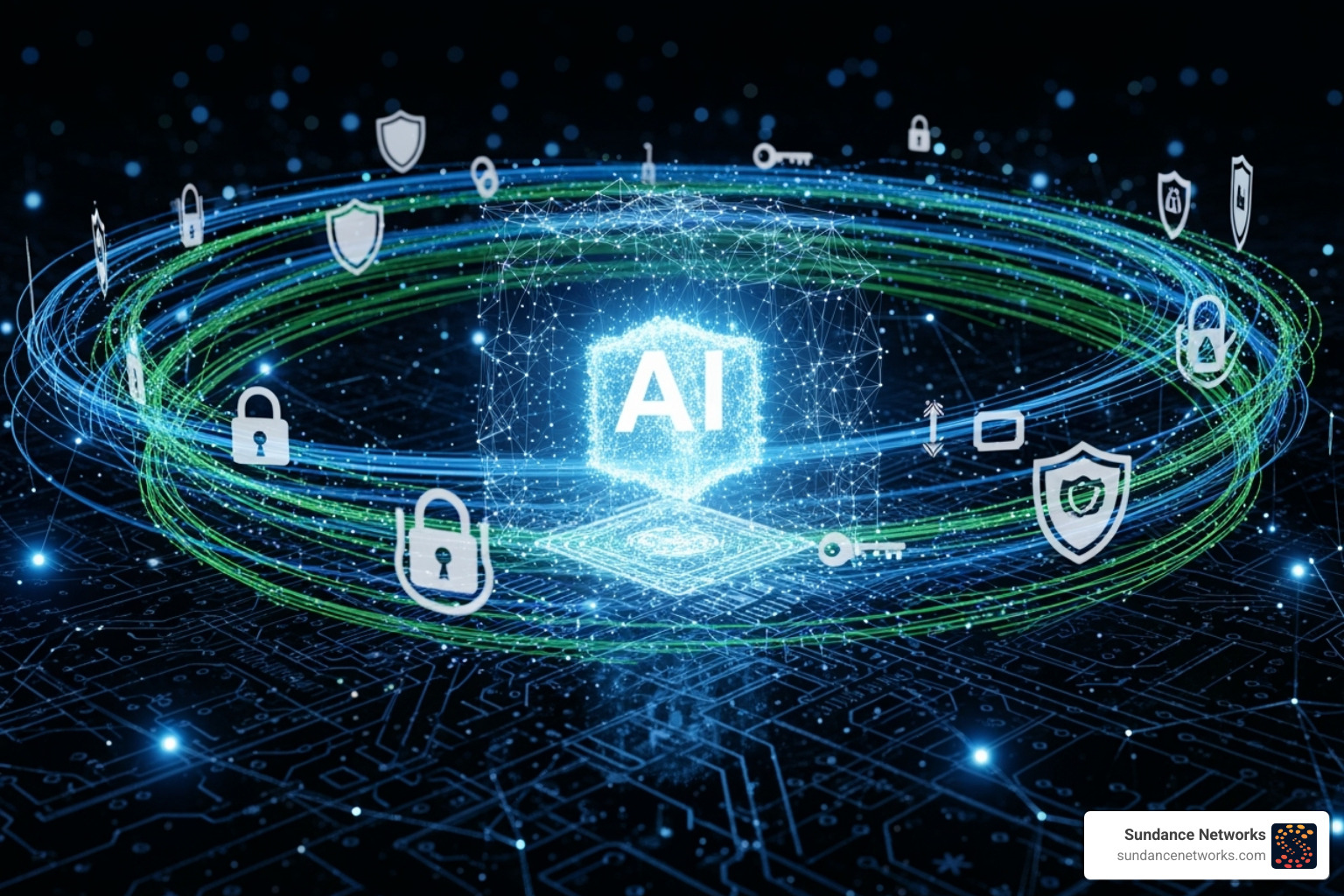Future proof technology isn’t about predicting breakthroughs; it’s about building systems that can adapt when change inevitably comes.
Technology becomes “future-proof” through adaptability, scalability, interoperability, modularity, and a commitment to open standards that prevent vendor lock-in.
The need for this approach is clear. While nearly 40% of university graduates struggle to align their skills with job demands, 70% of companies investing in automation report increased job creation. This paradox highlights that the future belongs to those who can adapt.
As one industry expert noted, predicting technology investments feels like looking into a crystal ball. The answer isn’t fortune-telling—it’s strategic planning.
Future-proofing is a journey, not a destination. It involves making smart choices today to keep options open tomorrow. For any business leader, understanding these principles is the key to thriving in a competitive market.

Understanding Future-Proof Technology: Beyond the Buzzword

It’s strategic approach to building solutions that can handle change. It’s not about creating an indestructible system that lasts forever, but about designing technology that is resilient and adaptable. Forbes characterizes the term as the ability to prepare for the future, innovate and adapt, which is precisely the goal.
This approach delivers tangible benefits. Business agility allows you to pivot when market conditions shift, providing a competitive advantage over rivals with rigid systems. The cost savings are also significant, as adaptable systems have a longer lifespan and require fewer costly replacements, leading to a solid ROI. Furthermore, modern tools improve employee effectiveness and satisfaction, as increased employee satisfaction has been shown to lead to increased productivity.
Why Future-Proofing is Vital for Modern All Businesses
The pace of change is accelerating, and businesses that fail to keep up are left behind. One major risk is technical debt—systems that are expensive to maintain, difficult to update, and hard to integrate with new solutions. Like financial debt, it becomes more costly the longer it’s ignored.
Simultaneously, market changes, shifting customer expectations, and shorter innovation cycles demand technological flexibility. Without it, businesses miss opportunities. Business continuity is another critical factor. A future-proof strategy includes robust disaster recovery and backup plans to ensure operations continue through any disruption, from cyberattacks to system failures.
The Common Misconceptions of Future-Proofing
- The Myth of Perfection: No technology is perfect or immune to updates. The goal is resilience, not permanence.
- Predicting the Future: Effective future-proofing isn’t about guessing what’s next. It’s about building systems that can adapt to whatever comes next.
- A One-Time Fix: Future-proofing is a continuous process of maintenance and investment, not a one-and-done project.
- Cost vs. Investment: While adaptable systems may have a higher upfront cost, they are a long-term investment that prevents the far greater expense of constantly replacing outdated technology.
- Ignoring Legacy Systems: Not all old systems need to be replaced. A strategic approach involves identifying which legacy systems to modernize, integrate, or decommission.
Core Principles for Building and Adopting Future-Proof Systems
Building with future proof technology is like using LEGO blocks instead of carving from stone—you want components that can be rearranged as needs change. The key isn’t predicting the future, but building systems that can adapt when it arrives.
Guiding principles like modularity, scalability, flexibility, and interoperability are the foundation of systems that last. By embracing automation and open standards, you build a platform ready for future challenges. At Sundance, we apply these principles daily through our IT Consulting and System Integration services.
Accept Modularity and Composability
Modularity involves breaking systems into smaller, independent services that work together. Instead of a monolithic application, you have components that can be updated or replaced individually. This is the core idea behind microservices architecture, where each service handles a specific function and communicates via APIs.
With 85% of new applications by 2025 expected to use microservices, the industry is clearly moving in this direction. An API-first design creates swappable components, reduces dependencies, and simplifies management. This also enables independent deployment, allowing teams to push updates to a single service without risking the entire system, which means faster, lower-risk releases.
Prioritize Scalability and Flexibility
Technology must grow and shrink with your business. Cloud computing is a game-changer, allowing you to scale resources up or down on demand instead of investing in fixed, on-premise hardware. This elasticity is your secret weapon against unpredictable demand.
With 90% of organizations expected to adopt hybrid cloud infrastructure by 2025, this flexible approach is becoming standard. It offers the control of on-premise systems with the adaptability of the cloud. Our On-Premise or Cloud Solutions help businesses find this balance. Pay-as-you-go models further improve flexibility, ensuring you only pay for the capacity you use.
Insist on Interoperability and Open Standards
Choosing systems that work well with others keeps your future options open and helps you avoid vendor lock-in. Key elements include data portability, which allows your information to move between systems, and standardized APIs, which ensure your technology can communicate with new solutions as they emerge.
Open-source software is often a valuable choice due to its strong community support and continuous improvement. Technologies built on accepted industry standards have greater longevity because they aren’t tied to a single company’s fate. Building on these foundations is an investment in long-term stability. This doesn’t mean avoiding all proprietary solutions, but ensuring they can integrate smoothly is critical.
The Future-Proof Tech Stack: Architectures and Technologies That Endure

Building a future proof technology stack is like constructing a house to withstand decades of change—it needs a solid foundation but also adaptable interiors. The key is choosing architectures and technologies that bend without breaking, moving from monolithic applications to distributed, cloud-native systems.
The secret isn’t chasing trends, but understanding which architectural patterns and technologies offer longevity and can grow with your business.
Architectural Patterns for a Resilient Future
Architecture is more critical than any single technology. The most fundamental choice is between monolithic and microservices architecture.
| Feature | Monolithic Architecture | Microservices Architecture |
|---|---|---|
| Structure | Single, tightly coupled application | Collection of small, independent, loosely coupled services |
| Development | Slower, single team, complex codebase | Faster, small independent teams, simpler codebases |
| Deployment | Single deployment for entire application | Independent deployment of each service |
| Scalability | Scales as a whole, often inefficient | Scales individual services as needed, highly efficient |
| Technology | Single tech stack for entire application | Polyglot (different tech for different services) |
| Resilience | Failure in one part can bring down the whole | Failure in one service doesn’t impact others |
| Maintenance | Complex, difficult to update and introduce new features | Easier to update, maintain, and introduce new features |
The fact that 85% of new applications in 2025 are expected to use microservices shows a clear industry shift toward adaptability. Other key patterns include Headless CMS (decoupling content from presentation), API gateways (managing traffic to services), event-driven architecture (enabling resilient, loosely coupled communication), and data-centric design (building systems around accessible data models).
Our IT Consulting and System Integration help businesses steer these choices.
Key Technologies Influencing Future-Proof Technology
Certain technologies are defining the future. Generative AI is automating complex tasks, creating content, and even writing code, while predictive analytics allows businesses to forecast trends instead of just reacting to them. The predictive analytics market is expected to grow at 21.7% annually through 2030.
The Internet of Things (IoT) is expanding into industrial applications, but its success depends on connectivity. WiFi 7 provides a massive leap, being 4.8 times faster than WiFi 6 with 5 times the capacity. Edge computing supports IoT by processing data closer to its source, reducing latency for time-sensitive applications. Meanwhile, Blockchain is finding practical use in supply chain transparency and secure transactions.
Our AI Solutions help businesses strategically integrate these technologies for real business value.
The Growing Importance of Cybersecurity in a Future-Proof Technology Strategy
As systems become more connected, they become bigger targets. Technology must be secure by design. 74% of security professionals reporting significant impacts from AI-powered cyber threats in 2024. In response, 95% believe AI will boost their own defenses.
Zero Trust architecture—never trust, always verify—is now a business necessity. It secures access for every user and device, regardless of location. AI in cybersecurity helps identify novel threats, predict attack patterns, and automate breach containment. At the same time, data privacy regulations like GDPR require building privacy-by-design principles into your systems to build customer trust.
Modern security has shifted to proactive threat detection using behavioral analytics and identity-centric security that protects users and devices beyond the traditional network perimeter. Our Cyber Security Services help businesses steer this complex landscape, ensuring digital assets remain protected as threats evolve.
Frequently Asked Questions about Future-Proofing IT
Is any technology truly 100% future-proof?
No technology is 100% future-proof, and that’s okay. The concept isn’t about finding a permanent solution but about building systems that can adapt. The goal is to maximize longevity and minimize the cost and disruption of inevitable changes. It’s about smart, resilient planning, not predicting the future.
How often should a business review its technology stack?
A comprehensive annual review is the minimum, but a continuous review process integrated into your regular business strategy and agile cycles is far more effective. This allows you to stay ahead of change rather than reacting to it. Key triggers for an immediate, deeper review include major market shifts, new security threats, or significant changes in business goals.
What’s more important for future-proofing: the technology itself or the team’s culture?
While technology is crucial, your team’s culture often matters more. An adaptable team with a growth mindset can make any technology work effectively and will know when and how to evolve it. Conversely, even cutting-edge technology will fail in a rigid, change-resistant culture. The ideal combination is a culture that accepts continuous learning and innovation, supported by smart technology choices. The human element is what truly drives successful future-proofing.
Build for Tomorrow, Starting Today
Future proof technology isn’t about predicting the future, but about building a foundation that can bend without breaking. It’s a practical, achievable strategy for resilience.
For businesses, this means embracing change as a constant. It requires choosing modular architectures, leveraging scalable cloud technologies, and embedding cybersecurity into your foundation. Adaptable technology is the key to thriving.
For individuals, the path is continuous learning. The most successful professionals are those who build their brand around adaptability and view technological shifts as opportunities.
The principles of future-proofing—flexibility, planning for change, and continuous learning—apply to any organization. At Sundance Networks, we’ve seen this mindset transform businesses by creating foundations that solve today’s problems and open up tomorrow’s possibilities.
To ensure your organization is built on a foundation of resilience and innovation, explore our Custom IT Consulting services. Because the future belongs to those who build for it, starting today.





